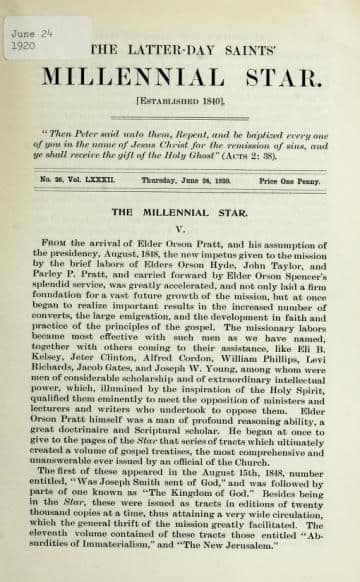Magazine
Historians of the Nephites

Title
Historians of the Nephites
Magazine
The Latter Day Saints' Millennial Star
Publication Type
Magazine Article
Year of Publication
1920
Authors
Roberts, B.H. (Primary)
Pagination
405–407
Date Published
24 June 1920
Volume
82
Issue Number
26
Abstract
This article is a listing and analysis of the historians in the Book of Mormon and where they stood relative to Nephite history.
HISTORIANS OF THE NEPHITES.
It may be interesting to such readers as are students of the Book of Mormon, and we trust their name is Legion, to consider for a short time who were the men to whom we are indebted for the annals of the Nephite nation, they being also the custodians of the Sacred Plates, the Urim and Thummim and other holy things.
The sacred records of the Nephites, from the time that Nephi, the founder of the nation, transferred them to the care of his brother Jacob, to the time that Moroni finally hid them in the hill Cumorah, were in the hands of four families, who had charge of them, as near as can be told from the abridgement that we have in the Book of Mormon, as follows: Jacob and his descendants held them from B.C. 546, to about B.C. 200, when they were transferred to King Benjamin, who, with his son Mosiah, the younger, held them until B.C. 91, at which time they were given into the care of Alma, the Chief Judge, and he and his posterity retained them until 320 years after the advent of the Messiah. After these, Mormon and Moroni were the custodians until the close of the record in the year 420 after Christ.
In the table that follows, B.C. signifies before Christ, and A. C. after Christ, counting from the true date of his birth as given in the Book of Mormon, and not from the accepted Christian Anno Domini (year of our Lord), which is now almost universally admitted to be from two to four years wrong. In those places where no date is given, the desired information is not afforded in the Book of Mormon, and therefore can only be guessed at. We therefore prefer to leave such places blank. It will also be remembered that Mormon, just before the last great battle, which resulted in the extinction of the Nephite nation, hid up in the hill Cumorah all the records which had been entrusted to him by the hand of the Lord, save it were the few plates which he gave to his son Moroni.
The following are the names of the Nephite historians, with the times during which they held the records:
Nephi, from — to 546 B.C.
Jacob, from 546 to — .
Enos, from — to 422.
Jarom, from 422 to 362.
Omni, from 362 to 318.
Amaron, from 318 to 280.
Chemish, from 280 to — .
Abinadom, from — to — .
Amaleki, from— to 200 (about).
King Benjamin, from 200 to 125.
King Mosiah, from 125 to 91.
Alma (the younger), from 91 to 73.
Helaman (the elder), from 73 to 57.
Shiblon, from 57 to 53.
Heleman, (the younger), from 53 to 39.
Nephi, from 39 to 1.
Nephi, (the disciple), from 1 to 34 A.D.
Nephi, from 34 to 110.
Amos, from 110 to 194.
Amos, from 194 to 306.
Ammaron, from 306 to 320.
Mormon, from 320 to 385.
Moroni, from 385 to 420.
In the above table, one thing will most certainly strike the attention of the observant reader. It is the lengthened period that some of the historians held the records. Jacob and his son Enos held them one hundred and twenty-four years, Jarom held them sixty. In this fact we find a very pleasing confirmation of the statement of Nephi that during the time he and his brethren were wandering in the wilderness, living on raw meat and suffering all kinds of hardships, fatigue and privations, the Lord so greatly blessed the women in the company that they “were strong, yea, even like unto the men,” having an abundance of milk to suckle the babes born unto them. Jacob was born at this time, and doubtless inherited an exceedingly strong constitution, which he transmitted to his posterity.
The second epoch at which the longevity of the custodians of the plates is remarkable is during that reign of universal righteousness which followed the ministry of the crucified Savior. By living unto the Lord in all things their lives were marvelously prolonged, especially the children of those generations, born during the continuance of this happy and holy period and before the effects of the after apostasy had began to work on the lives of those born during its blessed continuance. Thus Nephi, the son of Nephi the disciple, had charge of the records seventy-six years, his son Amos eighty-four years, and Amos, the son of the last named, the wonderful period of one hundred and twelve years, or father, son, and grandson, three generations, a total of two hundred and seventy-two years. What a powerful sermon this one fact preaches in favor of entire submission of body and soul to the perfect and perfecting law of God.
Subject Keywords
Bibliographic Citation
Terms of use
Items in the BMC Archive are made publicly available for non-commercial, private use. Inclusion within the BMC Archive does not imply endorsement. Items do not represent the official views of The Church of Jesus Christ of Latter-day Saints or of Book of Mormon Central.